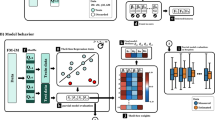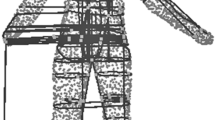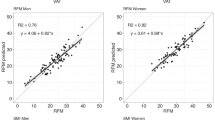Abstract
Background:
Conventional anthropometric measurements are time consuming and require well trained medical staff. To use three-dimensional whole body laser scanning in daily clinical work, validity, and reliability have to be confirmed.
Methods:
We compared a whole body laser scanner with conventional anthropometry in a group of 473 children and adolescents from the Leipzig Research Centre for Civilization Diseases (LIFE-Child). Concordance correlation coefficients (CCC) were calculated separately for sex, weight, and age to assess validity. Overall CCC (OCCC) was used to analyze intraobserver reliability.
Results:
Body height and the circumferences of waist, hip, upper arm, and calf had an “excellent” (CCC ≥ 0.9); neck and thigh circumference, a “good” (CCC ≥ 0.7); and head circumference, a “low” (CCC < 0.5) degree of concordance over the complete study population. We observed dependencies of validity on sex, weight, and age. Intraobserver reliability of both techniques is “excellent” (OCCC ≥ 0.9).
Conclusion:
Scanning is faster, requires less intensive staff training and provides more information. It can be used in an epidemiologic setting with children and adolescents but some measurements should be considered with caution due to reduced agreement with conventional anthropometry.
Similar content being viewed by others
Log in or create a free account to read this content
Gain free access to this article, as well as selected content from this journal and more on nature.com
or
References
Keys A, Fidanza F, Karvonen MJ, Kimura N, Taylor HL. Indices of relative weight and obesity. J Chronic Dis 1972;25:329–43.
Taylor RW, Jones IE, Williams SM, Goulding A. Evaluation of waist circumference, waist-to-hip ratio, and the conicity index as screening tools for high trunk fat mass, as measured by dual-energy X-ray absorptiometry, in children aged 3-19 y. Am J Clin Nutr 2000;72:490–5.
Hatipoglu N, Mazicioglu MM, Kurtoglu S, Kendirci M. Neck circumference: an additional tool of screening overweight and obesity in childhood. Eur J Pediatr 2010;169:733–9.
Kleiser C, Schienkiewitz A, Schaffrath Rosario A, Prinz-Langenohl R, Scheidt-Nave C, Mensink GB. Indicators of overweight and cardiovascular disease risk factors among 11- to 17-year-old boys and girls in Germany. Obes Facts 2011;4:379–85.
Kahn HS, Imperatore G, Cheng YJ. A population-based comparison of BMI percentiles and waist-to-height ratio for identifying cardiovascular risk in youth. J Pediatr 2005;146:482–8.
Nagy E, Vicente-Rodriguez G, Manios Y, et al. Harmonization process and reliability assessment of anthropometric measurements in a multicenter study in adolescents. Int J Obes (Lond) 2008;32 Suppl 5:65.
Padela AI, Rodriguez del Pozo P. Muslim patients and cross-gender interactions in medicine: an Islamic bioethical perspective. J Med Ethics 2011;37:40–4.
Jones PR, West GM, Harris DH, Read JB. The Loughborough anthropometric shadow scanner (LASS). Endeavour 1989;13:162–8.
Burke PH, Beard L. Stereophotogrammetry of the face. Am J Orthod 1967;53:769–82.
Rodríguez-Quiñonez JC, Sergiyenko O, Tyrsa V, et al. 3D body & medical scanners’ technologies: methodology and spatial discriminations. In: Sergiyenko O, ed. Optoelectronic Devices and Properties. Rijeka: INTECH Open Access Publisher, 2011.
Kau CH, Richmond S, Incrapera A, English J, Xia JJ. Three-dimensional surface acquisition systems for the study of facial morphology and their application to maxillofacial surgery. Int J Med Robot 2007;3:97–110.
Eder M, Brockmann G, Zimmermann A, et al. Evaluation of precision and accuracy assessment of different 3-D surface imaging systems for biomedical purposes. J Digit Imaging 2013;26:163–72.
Simmons KP, Istook CL. Body measurement techniques: comparing 3D body-scanning and anthropometric methods for apparel applications. J Fash Mark Manag 2003;7:306–32.
Kus A, Unver E, Taylor A. A comparative study of 3D scanning in engineering, product and transport design and fashion design education. Comput Appl Eng Educ 2009;17:263–71.
Zwane PE, Sithole M, Hunter L. A preliminary comparative analysis of 3D body scanner, manually taken girth body measurements and size chart measurements. Int J Consum Stud 2010;34:265–71.
Losken A, Fishman I, Denson DD, Moyer HR, Carlson GW. An objective evaluation of breast symmetry and shape differences using 3-dimensional images. Ann Plast Surg 2005;55:571–5.
Losken A, Seify H, Denson DD, Paredes AA Jr, Carlson GW. Validating three-dimensional imaging of the breast. Ann Plast Surg 2005;54:471–6; discussion 477–8.
Moyer HR, Carlson GW, Styblo TM, Losken A. Three-dimensional digital evaluation of breast symmetry after breast conservation therapy. J Am Coll Surg 2008;207:227–32.
Gaisberger C, Steininger P, Mitterlechner B, et al. Three-dimensional surface scanning for accurate patient positioning and monitoring during breast cancer radiotherapy. Strahlenther Onkol 2013;189:887–93.
Aldridge K, George ID, Cole KK, et al. Facial phenotypes in subgroups of prepubertal boys with autism spectrum disorders are correlated with clinical phenotypes. Mol Autism 2011;2:15.
Verzé L, Nasi A, Quaranta F, Vasino V, Prini V, Ramieri G. Quantification of facial movements by surface laser scanning. J Craniofac Surg 2011;22:60–5.
Thompson JT, David LR, Wood B, Argenta A, Simpson J, Argenta LC. Outcome analysis of helmet therapy for positional plagiocephaly using a three-dimensional surface scanning laser. J Craniofac Surg 2009;20:362–5.
Daniell N, Olds T, Tomkinson G. Technical note: Criterion validity of whole body surface area equations: a comparison using 3D laser scanning. Am J Phys Anthropol 2012;148:148–55.
Weinberg SM, Naidoo S, Govier DP, Martin RA, Kane AA, Marazita ML. Anthropometric precision and accuracy of digital three-dimensional photogrammetry: comparing the Genex and 3dMD imaging systems with one another and with direct anthropometry. J Craniofac Surg 2006;17:477–83.
Lee J, Kawale M, Merchant FA, et al. Validation of stereophotogrammetry of the human torso. Breast Cancer (Auckl) 2011;5:15–25.
Bretschneider T, Koop U, Schreiner V, Wenck H, Jaspers S. Validation of the body scanner as a measuring tool for a rapid quantification of body shape. Skin Res Technol 2009;15:364–9.
Kuehnapfel A, Ahnert P, Loeffler M, Broda A, Scholz M. Reliability of 3D laser-based anthropometry and comparison with classical anthropometry. Sci Rep 2016;6:26672.
Heuberger R, Domina T, MacGillivray M. Body scanning as a new anthropometric measurement tool for health-risk assessment. Int J Consum Stud 2008;32:34–40.
Wells JC, Stocks J, Bonner R, et al. Acceptability, precision and accuracy of 3D photonic scanning for measurement of body shape in a multi-ethnic sample of children aged 5-11 years: The SLIC Study. PLoS One 2015;10:e0124193.
Gorton GE 3rd, Young ML, Masso PD. Accuracy, reliability, and validity of a 3-dimensional scanner for assessing torso shape in idiopathic scoliosis. Spine (Phila Pa 1976) 2012;37:957–65.
Kau CH, Zhurov A, Scheer R, Bouwman S, Richmond S. The feasibility of measuring three-dimensional facial morphology in children. Orthod Craniofac Res 2004;7:198–204.
Quante M, Hesse M, Döhnert M, et al.; LIFE Child Study Investigators. The LIFE child study: a life course approach to disease and health. BMC Public Health 2012;12:1021.
Wabitsch M, Kunze D, Moß A. Konsensbasierte (S2) Leitlinie zur Diagnostik, Therapie und Prävention von Übergewicht und Adipositas im Kindes- und Jugendalter. http://www.aga.adipositas-gesellschaft.de/fileadmin/PDF/Leitlinien/AGA_S2_Leitlinie.pdf. Accessed 21 September 2016.
Vogel M. Calculation of standard deviation scores adduced from different growth standards. R package version 0.5., 2014. http://CRAN.R-project.org/package=childsds.
Kromeyer-Hauschild K, Wabitsch M, Kunze D, et al. Perzentile für den Body-mass-Index für das Kindes- und Jugendalter unter Heranziehung verschiedener deutscher Stichproben. Monatsschr Kinderheilkd 2001;149:807–18.
Lohman TG, ed. Anthropometric Standardization Reference Manual. Champaign IL: Human Kinetics Books, 1988.
Lin LI. A concordance correlation coefficient to evaluate reproducibility. Biometrics 1989;45:255–68.
Barnhart HX, Haber M, Song J. Overall concordance correlation coefficient for evaluating agreement among multiple observers. Biometrics 2002;58:1020–7.
McBride GB. A proposal for strength-of-agreement criteria for Lin’s Concordance Correlation Coefficient. NIWA Client Report: HAM2005-062 2005;(HAM2005-062).
Author information
Authors and Affiliations
Corresponding author
Supplementary information
Supplementary Tables
(ZIP 329 kb)
Rights and permissions
About this article
Cite this article
Glock, F., Vogel, M., Naumann, S. et al. Validity and intraobserver reliability of three-dimensional scanning compared with conventional anthropometry for children and adolescents from a population-based cohort study. Pediatr Res 81, 736–744 (2017). https://doi.org/10.1038/pr.2016.274
Received:
Accepted:
Published:
Issue date:
DOI: https://doi.org/10.1038/pr.2016.274
This article is cited by
-
Kinect-based anthropometric measurements: a comparative analysis of traditional methods in youth female weightlifters
BMC Sports Science, Medicine and Rehabilitation (2025)
-
The smart body concept as a demonstration of the overarching utility and benefits of 3D avatars in retail, health and wellbeing: an accuracy study of body measures from 3D reconstruction
Multimedia Tools and Applications (2023)
-
The aging human body shape
npj Aging and Mechanisms of Disease (2020)
-
Validity and reliability of three-dimensional scanning compared to conventional anthropometry for children and adolescents: methodological mistake
Pediatric Research (2017)
-
Response to Sabour
Pediatric Research (2017)



